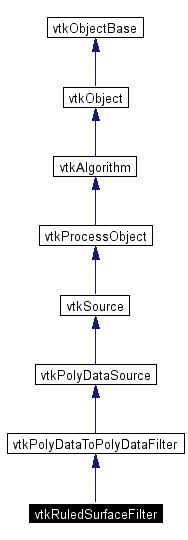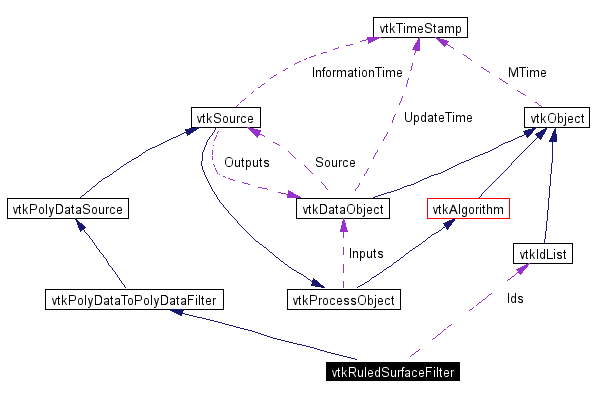vtkRuledSurfaceFilter Class Reference
#include <vtkRuledSurfaceFilter.h>
Inheritance diagram for vtkRuledSurfaceFilter:
 [legend]
[legend]Collaboration diagram for vtkRuledSurfaceFilter:
 [legend]List of all members.
[legend]List of all members.
Detailed Description
generates a surface from a set of lines
vtkRuledSurfaceFilter is a filter that generates a surface from a set of lines. The lines are assumed to be "parallel" in the sense that they do not intersect and remain somewhat close to one another. A surface is generated by connecting the points defining each pair of lines with straight lines. This creates a strip for each pair of lines (i.e., a triangulation is created from two generating lines). The filter can handle an arbitrary number of lines, with lines i and i+1 assumed connected. Note that there are several different approaches for creating the ruled surface, the method for creating the surface can either use the input points or resample from the polylines (using a user-specified resolution).
This filter offers some other important features. A DistanceFactor ivar is used to decide when two lines are too far apart to connect. (The factor is a multiple of the distance between the first two points of the two lines defining the strip.) If the distance between the two generating lines becomes too great, then the surface is not generated in that region. (Note: if the lines separate and then merge, then a hole can be generated in the surface.) In addition, the Offset and OnRation ivars can be used to create nifty striped surfaces. Closed surfaces (e.g., tubes) can be created by setting the CloseSurface ivar. (The surface can be closed in the other direction by repeating the first and last point in the polylines defining the surface.)
An important use of this filter is to combine it with vtkStreamLine to generate stream surfaces. It can also be used to create surfaces from contours.
- Warning:
- The number of lines must be greater than two if a surface is to be generated. sides (i.e., a ribbon), use vtkRibbonFilter.
- See also:
- vtkRibbonFilter vtkStreamLine
- Created by:
-
- CVS contributions (if > 5%):
-
- CVS logs (CVSweb):
/Graphics/vtkRuledSurfaceFilter.h)/Graphics/vtkRuledSurfaceFilter.cxx)
- Examples:
- vtkRuledSurfaceFilter (Examples)
- Tests:
- vtkRuledSurfaceFilter (Tests)
Definition at line 81 of file vtkRuledSurfaceFilter.h.
Member Typedef Documentation
Constructor & Destructor Documentation
| vtkRuledSurfaceFilter::vtkRuledSurfaceFilter |
( |
|
) |
[protected] |
|
Member Function Documentation
| virtual const char* vtkRuledSurfaceFilter::GetClassName |
( |
|
) |
[virtual] |
|
| int vtkRuledSurfaceFilter::IsTypeOf |
( |
const char * |
type |
) |
[static] |
|
|
|
Return 1 if this class type is the same type of (or a subclass of) the named class. Returns 0 otherwise. This method works in combination with vtkTypeRevisionMacro found in vtkSetGet.h.
Reimplemented from vtkPolyDataToPolyDataFilter. |
| virtual int vtkRuledSurfaceFilter::IsA |
( |
const char * |
type |
) |
[virtual] |
|
|
|
Return 1 if this class is the same type of (or a subclass of) the named class. Returns 0 otherwise. This method works in combination with vtkTypeRevisionMacro found in vtkSetGet.h.
Reimplemented from vtkPolyDataToPolyDataFilter. |
| void vtkRuledSurfaceFilter::PrintSelf |
( |
ostream & |
os, |
|
|
vtkIndent |
indent |
|
) |
[virtual] |
|
|
|
Methods invoked by print to print information about the object including superclasses. Typically not called by the user (use Print() instead) but used in the hierarchical print process to combine the output of several classes.
Reimplemented from vtkPolyDataToPolyDataFilter. |
|
|
Construct object with OnRatio=1, Offset=0. DistanceFactor=3.0, CloseSurface off, and PassLines off.
Reimplemented from vtkAlgorithm. |
| virtual void vtkRuledSurfaceFilter::SetDistanceFactor |
( |
double |
|
) |
[virtual] |
|
|
|
Set/Get the factor that controls tearing of the surface. |
| virtual double vtkRuledSurfaceFilter::GetDistanceFactor |
( |
|
) |
[virtual] |
|
|
|
Set/Get the factor that controls tearing of the surface. |
| virtual void vtkRuledSurfaceFilter::SetOnRatio |
( |
int |
|
) |
[virtual] |
|
|
|
Control the striping of the ruled surface. If OnRatio is greater than 1, then every nth strip is turned on, beginning with the Offset strip. |
| virtual int vtkRuledSurfaceFilter::GetOnRatio |
( |
|
) |
[virtual] |
|
|
|
Control the striping of the ruled surface. If OnRatio is greater than 1, then every nth strip is turned on, beginning with the Offset strip. |
| virtual void vtkRuledSurfaceFilter::SetOffset |
( |
int |
|
) |
[virtual] |
|
|
|
Control the striping of the ruled surface. The offset sets the first stripe that is visible. Offset is generally used with OnRatio to create nifty striping effects. |
| virtual int vtkRuledSurfaceFilter::GetOffset |
( |
|
) |
[virtual] |
|
|
|
Control the striping of the ruled surface. The offset sets the first stripe that is visible. Offset is generally used with OnRatio to create nifty striping effects. |
| virtual void vtkRuledSurfaceFilter::SetCloseSurface |
( |
int |
|
) |
[virtual] |
|
|
|
Indicate whether the surface is to be closed. If this boolean is on, then the first and last polyline are used to generate a stripe that closes the surface. (Note: to close the surface in the other direction, repeat the first point in the polyline as the last point in the polyline.) |
| virtual int vtkRuledSurfaceFilter::GetCloseSurface |
( |
|
) |
[virtual] |
|
|
|
Indicate whether the surface is to be closed. If this boolean is on, then the first and last polyline are used to generate a stripe that closes the surface. (Note: to close the surface in the other direction, repeat the first point in the polyline as the last point in the polyline.) |
| virtual void vtkRuledSurfaceFilter::CloseSurfaceOn |
( |
|
) |
[virtual] |
|
|
|
Indicate whether the surface is to be closed. If this boolean is on, then the first and last polyline are used to generate a stripe that closes the surface. (Note: to close the surface in the other direction, repeat the first point in the polyline as the last point in the polyline.) |
| virtual void vtkRuledSurfaceFilter::CloseSurfaceOff |
( |
|
) |
[virtual] |
|
|
|
Indicate whether the surface is to be closed. If this boolean is on, then the first and last polyline are used to generate a stripe that closes the surface. (Note: to close the surface in the other direction, repeat the first point in the polyline as the last point in the polyline.) |
| virtual void vtkRuledSurfaceFilter::SetRuledMode |
( |
int |
|
) |
[virtual] |
|
|
|
Set the mode by which to create the ruled surface. (Dramatically different results are possible depending on the chosen mode.) The resample mode evenly resamples the polylines (based on length) and generates triangle strips. The point walk mode uses the existing points and walks around the polyline using existing points. |
| virtual int vtkRuledSurfaceFilter::GetRuledMode |
( |
|
) |
[virtual] |
|
|
|
Set the mode by which to create the ruled surface. (Dramatically different results are possible depending on the chosen mode.) The resample mode evenly resamples the polylines (based on length) and generates triangle strips. The point walk mode uses the existing points and walks around the polyline using existing points. |
| void vtkRuledSurfaceFilter::SetRuledModeToResample |
( |
|
) |
[inline] |
|
|
|
Set the mode by which to create the ruled surface. (Dramatically different results are possible depending on the chosen mode.) The resample mode evenly resamples the polylines (based on length) and generates triangle strips. The point walk mode uses the existing points and walks around the polyline using existing points.
Definition at line 133 of file vtkRuledSurfaceFilter.h.
References VTK_RULED_MODE_RESAMPLE. |
| void vtkRuledSurfaceFilter::SetRuledModeToPointWalk |
( |
|
) |
[inline] |
|
|
|
Set the mode by which to create the ruled surface. (Dramatically different results are possible depending on the chosen mode.) The resample mode evenly resamples the polylines (based on length) and generates triangle strips. The point walk mode uses the existing points and walks around the polyline using existing points.
Definition at line 135 of file vtkRuledSurfaceFilter.h.
References VTK_RULED_MODE_POINT_WALK. |
| const char* vtkRuledSurfaceFilter::GetRuledModeAsString |
( |
|
) |
|
|
|
|
Set the mode by which to create the ruled surface. (Dramatically different results are possible depending on the chosen mode.) The resample mode evenly resamples the polylines (based on length) and generates triangle strips. The point walk mode uses the existing points and walks around the polyline using existing points. |
| virtual void vtkRuledSurfaceFilter::SetResolution |
( |
int |
, |
|
|
int |
|
|
) |
[virtual] |
|
|
|
If the ruled surface generation mode is RESAMPLE, then these parameters are used to determine the resample rate. Resolution[0] defines the resolution in the direction of the polylines; Resolution[1] defines the resolution across the polylines (i.e., direction orthogonal to Resolution[0]). |
| void vtkRuledSurfaceFilter::SetResolution |
( |
int |
[2] |
) |
|
|
|
|
If the ruled surface generation mode is RESAMPLE, then these parameters are used to determine the resample rate. Resolution[0] defines the resolution in the direction of the polylines; Resolution[1] defines the resolution across the polylines (i.e., direction orthogonal to Resolution[0]). |
| virtual int* vtkRuledSurfaceFilter::GetResolution |
( |
|
) |
[virtual] |
|
|
|
If the ruled surface generation mode is RESAMPLE, then these parameters are used to determine the resample rate. Resolution[0] defines the resolution in the direction of the polylines; Resolution[1] defines the resolution across the polylines (i.e., direction orthogonal to Resolution[0]). |
| virtual void vtkRuledSurfaceFilter::GetResolution |
( |
int |
data[2] |
) |
[virtual] |
|
|
|
If the ruled surface generation mode is RESAMPLE, then these parameters are used to determine the resample rate. Resolution[0] defines the resolution in the direction of the polylines; Resolution[1] defines the resolution across the polylines (i.e., direction orthogonal to Resolution[0]). |
| virtual void vtkRuledSurfaceFilter::SetPassLines |
( |
int |
|
) |
[virtual] |
|
|
|
Indicate whether the generating lines are to be passed to the output. By defualt lines are not passed to the output. |
| virtual int vtkRuledSurfaceFilter::GetPassLines |
( |
|
) |
[virtual] |
|
|
|
Indicate whether the generating lines are to be passed to the output. By defualt lines are not passed to the output. |
| virtual void vtkRuledSurfaceFilter::PassLinesOn |
( |
|
) |
[virtual] |
|
|
|
Indicate whether the generating lines are to be passed to the output. By defualt lines are not passed to the output. |
| virtual void vtkRuledSurfaceFilter::PassLinesOff |
( |
|
) |
[virtual] |
|
|
|
Indicate whether the generating lines are to be passed to the output. By defualt lines are not passed to the output. |
| void vtkRuledSurfaceFilter::Execute |
( |
|
) |
[protected, virtual] |
|
|
|
This method is the old style execute method
Reimplemented from vtkSource. |
Member Data Documentation
The documentation for this class was generated from the following file:

